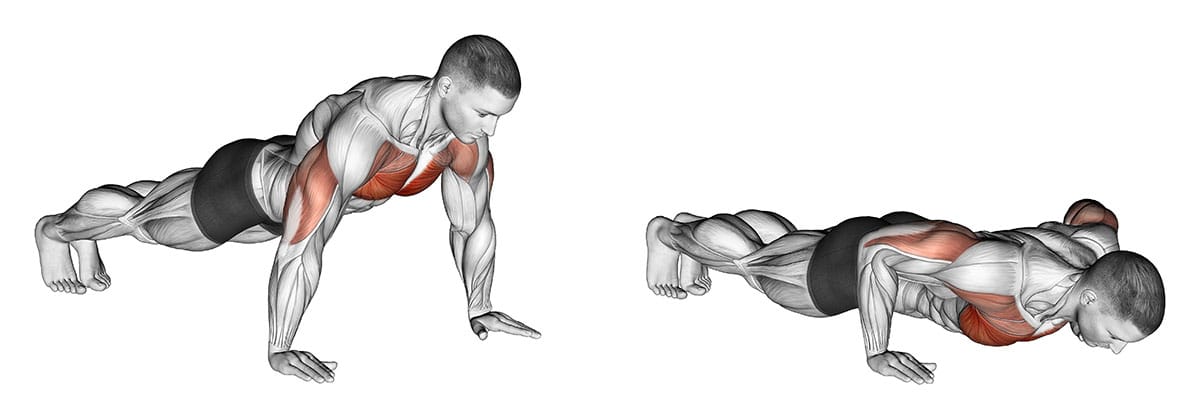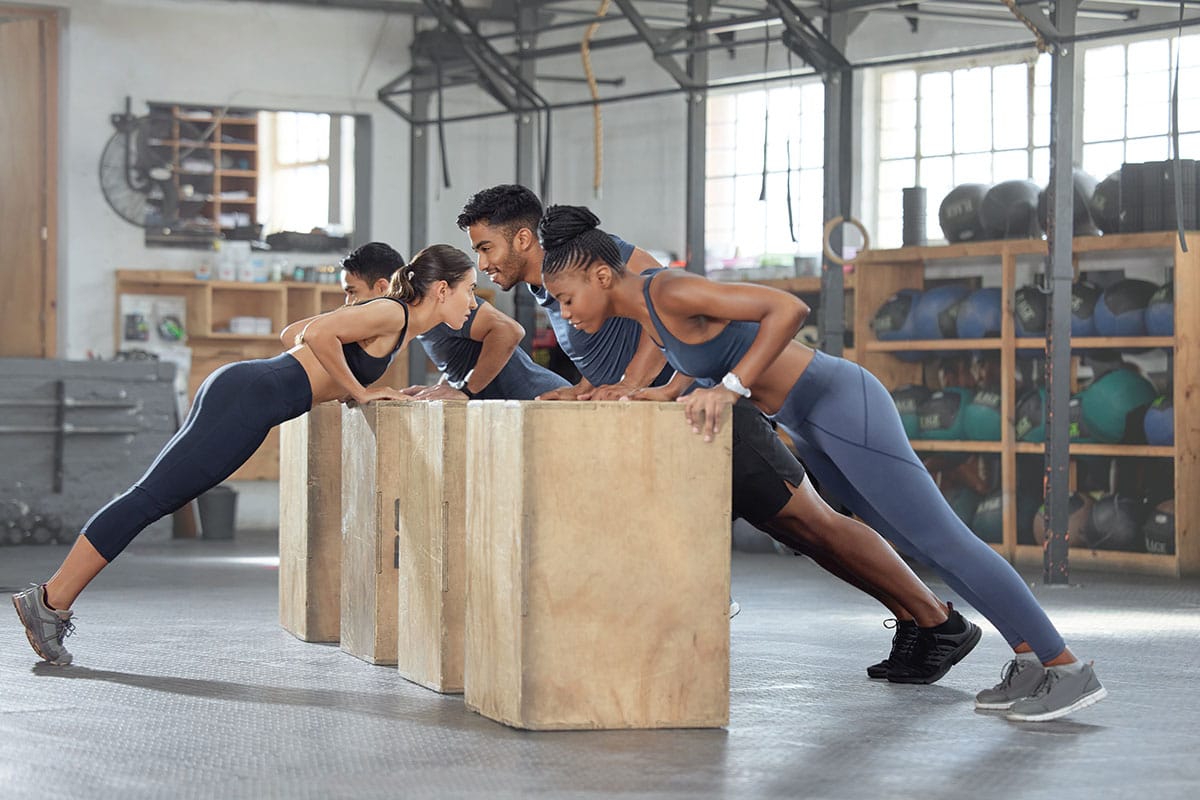Lower Chest Push-Ups: Best Variations for Huge Lower Pecs
Learn how to do lower chest push-ups. Get to know how incline and standard push-ups can grow your lower chest.
If you’re looking to grow your chest but struggle with bad chest genetics, you’ve come to the right place.
Getting an aesthetically pleasing chest with proper volume throughout the muscles is a sore spot for most.
Usually, those pesky pecs on the lower chest seem to refuse any attempts to make them grow!
This article will unpack a few key topics and explore how you can counteract a weak or small chest with lower chest push-ups. We’ll look at:
- Why is it so hard to grow the lower chest?
- Which push-ups are best for the lower chest?
- Benefits of lower chest push-ups
- Lower chest push-ups— muscles worked
To answer all these questions and more, take a look at this simple and comprehensive guide to lower chest push-ups.
Best Lower Chest Push-Ups
These are the best push-up variations to use if you want to target, isolate and grow the muscles of your lower chest.
1. Incline Push-Ups
If you want to hone in on your lower chest, incline push-ups are the best lower chest push-up variation to do this.

Why?
Adjusting the height of your push-up to create a 45-degree incline can more effectively target the muscle fibers in the lower part of your chest.
You can adjust the angle as needed based on your personal preference and comfort level, but incline variation is generally considered the most effective lower chest push-up.
How do you do an incline push-up?
- Set-Up: Stand in front of a sturdy block, weight bench, chair, or any other stable, elevated platform that works for you. Place your hands on the elevated surface about shoulder-width apart, and come into a high plank position with your shoulders stacked over your wrists. You’ll want your chosen equipment to sit high enough so your body is approximately a 45-degree angle from the ground when you press up into your plank.
- Body Position: Your body should form a straight line from head to heels. Because you’re working on an incline, the line will be steeper than you’d see in a traditional push-up. Keep your elbows 45 degrees away from your body, pointing back toward your feet.
- Lower Down: Inhale as you bend your elbows to lower your body. Your elbows should come to about a 90-degree bend so your chest hovers just above your bench or block.
- Push-Up: Exhale as you push through your palms to return to the starting position. Don’t let your hips sag down below the rest of your body or pike up as you do this.
- Reps: Aim for 3-4 sets of 6-12 clean reps.
2. Traditional Push-Ups
Standard push-ups are among the best lower chest push-ups to target growth and strength.

- Set-Up: Come into a high plank position with your shoulders stacked over your wrists.
- Body Position: Your body should form a straight line from head to heels. Keep your elbows 45 degrees from your body, pointing back toward your feet.
- Lower Down: Lower your body by bending your elbows, which should be about a 90-degree bend so your chest hovers just above the ground.
- Push-Up: Drive out of your palms and exhale forcefully as you push yourself back up to your high plank position. Don’t let your hips sag down below the rest of your body or pike up as you do this.
- Reps: Aim for 3-4 sets of 6-12 clean reps.
Pro-Tip: If you find standard push-ups too challenging as a beginner, try working on your push-ups from the knees.
To do this, you can use the steps above, but start from a plank position on your knees with your ankles lightly crossed or in a comfortable position behind you.
Best Lower Chest Exercises
It’s a great thing to incorporate push-up variations into your workout routine.
These are some of the fundamental building blocks of a great fitness plan. Some of the greats in history have been known for their hundred- or thousand-rep push-up workouts. The Herschel Walker workout, for instance, was rumored to consist of around 1,500 push-ups per day!
If you don’t enjoy push-ups and find yourself skipping them, there are a few other key moves you can use to grow a broader lower chest.
Some alternative lower chest exercises include:
- Decline bench press (a great compound chest exercise)
- Cable crossover (a wonderful lower chest cable exercise)
- Chest dip
- Seated chest fly (also a good chest exercise for inner chest)
Scott Herman demonstrates the proper technique for the decline bench press— an alternative to lower chest push-ups if you want to grow your low pecs.
So, if you want to skip the push-ups entirely or simply add some chest isolation exercises on top of your compound exercises (push-ups) to grow a bigger chest, you can add or subtract these moves as you like!
What Are the Benefits of Lower Chest Push-Ups?
Like any push-up variation, lower chest push-ups are a great way to:
- Increase calorie burn and boost metabolism
- Strengthen the arm, chest, and core muscles
- Build muscle tone and definition in the chest when paired with a protein-rich diet or calorie deficit for fat loss.
Let’s assume that we’re working directly on incline push-ups. This variation specifically also offers a few added benefits.
1. Less Joint Pain
Elevating your push-ups with a weight bench comes with this key advantage: less joint pain!

Whether you’re young or old, this is something to celebrate.
Although some people consider the incline push-up easier than a traditional push-up because you’re bearing less weight, it also puts less strain on joints like your wrists, shoulders, and elbows.
If you’re injury-prone, this is a great relief and can save you from the type of wounds that could cost you a sports season.
For those who simply feel a lot of pain from push-ups, using an incline variation of the lower chest push-up offers you a gentler way to work the joints.
2. Corrects Lower Chest Size Imbalances
You’re probably hoping to get in Greek God workouts that will leave you with the chest of Zeus with an even better pump.
But if you seem to be trying and failing and your chest just looks all around puny, there’s a good chance you’re lacking in volume in the lower chest.
Don’t feel alone if this is you!
Most weightlifters, especially guys, cite a small lower chest (along with pesky, small calves) as one of their main struggle spots.
You may be wondering, “Why is my lower chest not growing?”
Typically, the answer is that you’re not using moves like lower chest push-ups or the decline bench press to target this area directly. If you incorporate more of these moves into your workout split at adequate volume and weight each week, you should start to notice more size and better balance in your lower chest.
3. Unique Variation
Finally, incline push-ups can simply be more fun if you’re getting tired of standard push-ups!

If you often find yourself too lazy to workout, it’s possible that your gym routine is simply boring.
Changing it up will help you continue to push yourself physically while offering something new and exciting mentally.
This helps reduce the monotony of doing the same workouts day in and day out and can even keep you more motivated to avoid skipping days in the gym.
What Muscles Do Lower Chest Push-Ups Work?
The lower chest (obviously)!
Here’s the breakdown of the specific muscles that play a role when it comes to lower chest push-ups.
Pectoralis Major
Usually, when we refer to the pectorals (aka “pecs”) we are referring to the pectoralis major. This is the largest and strongest chest muscle that sits right under your breast tissue across the full span of your chest.
During a push-up, your pectoralis major acts as what’s called a “prime mover” (according to Essentials of Human Physiology) or agonist muscle.
These muscles are responsible for generating the main force to power a given movement. In a push-up, your pectoralis major is the strongest, largest and most powerful muscle at play.
Pectoralis Minor
The pectoralis minor is a smaller chest muscle that sits deep to the pectoralis major. The pectoralis minor helps to depress (lower) your scapulae (shoulder blades).
It’s one of the major muscles that helps stabilize your shoulder girdle, so it holds your shoulders in place as you push up and lower down. Pectoralis minor is also associated with breathing and breath control— which makes executing your push-ups a lot easier!

Triceps
These horseshoe-shaped muscles sit on the backs of your arms. Triceps work to extend your arms at the elbows. When you are returning to your high plank position from the low part of your push-up, driving your body back up means you need to engage your triceps to press.
They’re one of the key muscles associated with pushing or pressing strength. You’re probably used to training them as part of your push day workout.
Anterior Deltoids
The deltoids are the muscles that give your shoulders their rounded shape. If you train to achieve 3D shoulders (aka “boulder shoulders), the main thing you’ll need to do is build up your delts.
The anterior deltoid, specifically means the front part of your delt. In a push-up, these muscles help you adduct your shoulders, meaning to bring your arms inward towards the chest across the shoulder joint.
This helps you stay in perfect position during lower chest push-ups.
Core
Your abdominal muscles, obliques, and even your pelvic floor muscles are all referred to as “the core.” By some definitions, this area can even encompass your hip flexors and muscles along the spine (erector spinae). Most of the muscles that anchor to either the spine or pelvis can constitute part of your core.
When you think about holding the straight line of your body from head to heels, most of what you need to stay upright is proper core engagement. By keeping your core stable, you prevent your hips from sagging or hiking up as you lower down and push up.
This way, your body moves as a single, controlled unit.
The Takeaway
Lower chest push-ups are a great way to increase your chest muscles if you struggle with looking scrawny.
Generally, from an aesthetic standpoint, a weak lower chest is the main part of the chest that will sabotage the way your upper body looks.
Most weightlifters struggle to grow their lower chest muscles since many chest exercises aren’t designed specifically to isolate that part of the chest.
Fortunately, there are a few workarounds you can use with push-ups. The best lower chest push-up variation is the incline push-up.
By working with an elevated bench or block that sits around 45 degrees, you effectively hit the lower portion of your chest with your push-ups.
Perfecting your standard push-ups is a great way to grow your chest too, although the effort will be more evenly distributed throughout the whole chest.
Don’t forget to add some accessory moves to your push-up sessions. Including supplementary exercises like chest flyes, cable crossovers, decline bench presses and chest dips will set you on your course to a stronger and better-looking lower chest!
References
Laurie K. McCorry, Martin M. Zdanowicz, Cynthia Y. Gonnella in Essentials of Human Physiology and Pathophysiology for Pharmacy and Allied Health, 2019.
Related articles


Get fit with Flex
Build muscle & lose weight fast for free.
Available on iPhone + Apple Watch





